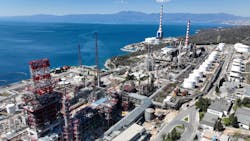Croatia’s INA confirms Rijeka refinery’s readiness for SAF production
Croatia’s INA Industrija Nafte DD—a member of MOL Group—has completed a pilot confirming capability for production of sustainable aviation fuel (SAF) using existing equipment at the operator’s 90,000-b/d Rijeka refinery on the Urinj Peninsula, along the northern part of the Adriatic Sea.
In a pilot project executed between May 5-13, 2025, INA tested co-processing of 1,000 tonnes 5% palm oil mill effluent (POME) biogenic feedstock with conventional crude oil at the Rijeka refinery’s existing hydrocracking unit to produce both SAF and renewable diesel, or hydrotreated vegetable oil (HVO), the operator said in mid July.
Developed over the course of 8 months and carried out in collaboration with Chevron Lummus Global—the hydrocracking unit’s technology licensor—the pilot program required certain modifications to existing equipment, including the addition of specialized filters to increase capacities of and ensure controlled handling of the specialty biogenic feedstock by the refinery’s existing hydrocracking and vacuum distillation units.
During the pilot’s production test run, INA collected more than 400 samples for detailed analysis at its own Central Testing Laboratory (CIL), with C14 analysis of biogenic content carried out by accredited external laboratories Ruđer Bošković Institute in Zagreb, Croatia, and Isotoptech Zrt. of Debrecen, Hungary.
The independent testing of SAF and HVO volumes resulting from the pilot program—the entire process of which was certified by independent auditor Bureau Veritas d.o.o.— has confirmed production complies with ISCC System GmbH’s International Sustainability Carbon Certification (ISCC) standards for sustainable biofuels, INA said.
The ISCC certification—which includes the ISCC European Union (EU) and ISCC Carbon Offsetting and Reduction Scheme for International Aviation (CORSIA) PLUS co-processing certifications—paves the way for INA to proceed with its plan to complete all preparatory activities to enable ongoing production of SAF from the Rijeka refinery for supply to the market by 2029, the company said.
“Processing biogenic feedstock within existing infrastructure is one of the most efficient ways to decarbonize refinery operations and increase the share of renewables in the transport sector,” said Ivica Jerbić, INA’s director of development.
“Thanks to the commitment of our internal team and the collaboration with partners from MOL Group and CLG, we have successfully created the necessary preconditions to meet the future needs of the market and our customers,” Jerbić added.
While INA did not reveal further details regarding a timeframe or specific works to be included in preparing the refinery for long-term renewable fuels production, Goran Pleše—INA’s operating director of refining and marketing—said successful completion f the pilot project “has created the foundation for further activities and the introduction of continuous biogenic feedstock processing at [Rijeka] in the near future.”
Greening at Rijeka refinery
The refinery’s implementation of renewables production comes as part of INA’s broader program to reduce the carbon footprint of its operations in alignment with the European Union’s renewable energy regulations, which by 2030 will require EU member states to ensure an appropriate share of renewables in the transport sector, with a particular focus on advanced biofuels and SAF.
The operator also is executing a green hydrogen project at Rijeka, including construction of an 11-Mw photovoltaic (PV) power plant and a 10-Mw proton exchange membrane electrolyzer (PEMEL) to produce 1,500 kg/year of green hydrogen using 100% sustainable electricity, the company said in its latest annual report.
Renewable electricity for hydrogen production will come from the PV plant and green power purchase agreements, INA said.
Slated for mechanical completion by yearend 2026, green hydrogen production from the project is targeted to reach full capacity presumably in 2027.
INA said the Rijeka refinery will use any surplus green hydrogen produced from plant to decarbonize the processing site’s own operations, replacing the refinery’s current consumption of fossil-derived conventional hydrogen.
The planned renewable fuels and green hydrogen developments at Rijeka join INA’s other projects at the site, including a proposed €6-million seabed remediation program, as well as the refinery’s ongoing modernization program, the latter of which is due for mechanical completion by yearend 2025 (OGJ Online, July 15, 2025; June 29, 2020).
About the Author
Robert Brelsford
Downstream Editor
Robert Brelsford joined Oil & Gas Journal in October 2013 as downstream technology editor after 8 years as a crude oil price and news reporter on spot crude transactions at the US Gulf Coast, West Coast, Canadian, and Latin American markets. He holds a BA (2000) in English from Rice University and an MS (2003) in education and social policy from Northwestern University.

